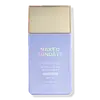Ultra Violette Queen Screen SPF 50 Super Glow Drops Versus Naked Sundays Cabana Glow Mineral Glow Serum Drops SPF 50
What's inside
What's inside
 Key Ingredients
Key Ingredients

 Benefits
Benefits

 Concerns
Concerns

 Ingredients Side-by-side
Ingredients Side-by-side

Water
Skin ConditioningHomosalate
Skin ConditioningOctyldodecanol
EmollientDicaprylyl Ether
EmollientMethylene Bis-Benzotriazolyl Tetramethylbutylphenol
UV FilterBis-Ethylhexyloxyphenol Methoxyphenyl Triazine
Skin ConditioningPropanediol
SolventDicaprylyl Carbonate
EmollientCetyl Alcohol
EmollientEthylhexyl Triazone
UV AbsorberLauryl Glucoside
CleansingPolyglyceryl-2 Dipolyhydroxystearate
Skin ConditioningGlycerin
HumectantCI 77492
Cosmetic ColorantMicrocrystalline Cellulose
AbsorbentPoly C10-30 Alkyl Acrylate
Emulsion StabilisingDecyl Glucoside
CleansingOryza Sativa Bran Wax
Skin ConditioningPhenoxyethanol
PreservativeHydroxyacetophenone
AntioxidantCI 77491
Cosmetic ColorantCI 77499
Cosmetic ColorantSaccharide Isomerate
HumectantCellulose Gum
Emulsion StabilisingPolyhydroxystearic Acid
EmulsifyingEthylhexylglycerin
Skin ConditioningSodium Lauroyl Sarcosinate
CleansingDisodium EDTA
Propylene Glycol
HumectantXanthan Gum
EmulsifyingSodium Citrate
BufferingCitric Acid
BufferingTocopherol
AntioxidantWater, Homosalate, Octyldodecanol, Dicaprylyl Ether, Methylene Bis-Benzotriazolyl Tetramethylbutylphenol, Bis-Ethylhexyloxyphenol Methoxyphenyl Triazine, Propanediol, Dicaprylyl Carbonate, Cetyl Alcohol, Ethylhexyl Triazone, Lauryl Glucoside, Polyglyceryl-2 Dipolyhydroxystearate, Glycerin, CI 77492, Microcrystalline Cellulose, Poly C10-30 Alkyl Acrylate, Decyl Glucoside, Oryza Sativa Bran Wax, Phenoxyethanol, Hydroxyacetophenone, CI 77491, CI 77499, Saccharide Isomerate, Cellulose Gum, Polyhydroxystearic Acid, Ethylhexylglycerin, Sodium Lauroyl Sarcosinate, Disodium EDTA, Propylene Glycol, Xanthan Gum, Sodium Citrate, Citric Acid, Tocopherol
Titanium Dioxide 3.3%
Cosmetic ColorantZinc Oxide 14.9%
Cosmetic ColorantAluminum Hydroxide
EmollientButyloctyl Salicylate
Skin ConditioningC12-15 Alkyl Benzoate
AntimicrobialCoco-Caprylate/Caprate
EmollientDimethicone
EmollientDunaliella Salina Extract
Skin ConditioningGlycerin
HumectantEthylhexyl Methoxycrylene
Skin ConditioningEthylhexylglycerin
Skin ConditioningHibiscus Sabdariffa Flower Extract
Skin ConditioningHydroxyacetophenone
AntioxidantIron Oxides
Isododecane
EmollientIsostearic Acid
CleansingLauryl PEG-8 Dimethicone
Magnesium Sulfate
Mica
Cosmetic ColorantPhenoxyethanol
PreservativePolyglyceryl-2 Tetraisostearate
EmollientPolyglyceryl-3 Polyricinoleate
EmulsifyingPropanediol
SolventWater
Skin ConditioningSimmondsia Chinensis Seed Oil
EmollientSodium Benzoate
MaskingSodium Hyaluronate
HumectantStearic Acid
CleansingCI 77891
Cosmetic ColorantTitanium Dioxide 3.3%, Zinc Oxide 14.9%, Aluminum Hydroxide, Butyloctyl Salicylate, C12-15 Alkyl Benzoate, Coco-Caprylate/Caprate, Dimethicone, Dunaliella Salina Extract, Glycerin, Ethylhexyl Methoxycrylene, Ethylhexylglycerin, Hibiscus Sabdariffa Flower Extract, Hydroxyacetophenone, Iron Oxides, Isododecane, Isostearic Acid, Lauryl PEG-8 Dimethicone, Magnesium Sulfate, Mica, Phenoxyethanol, Polyglyceryl-2 Tetraisostearate, Polyglyceryl-3 Polyricinoleate, Propanediol, Water, Simmondsia Chinensis Seed Oil, Sodium Benzoate, Sodium Hyaluronate, Stearic Acid, CI 77891
 Reviews
Reviews

Ingredients Explained
These ingredients are found in both products.
Ingredients higher up in an ingredient list are typically present in a larger amount.
Ethylhexylglycerin (we can't pronounce this either) is commonly used as a preservative and skin softener. It is derived from glyceryl.
You might see Ethylhexylglycerin often paired with other preservatives such as phenoxyethanol. Ethylhexylglycerin has been found to increase the effectiveness of these other preservatives.
Glycerin is already naturally found in your skin. It helps moisturize and protect your skin.
A study from 2016 found glycerin to be more effective as a humectant than AHAs and hyaluronic acid.
As a humectant, it helps the skin stay hydrated by pulling moisture to your skin. The low molecular weight of glycerin allows it to pull moisture into the deeper layers of your skin.
Hydrated skin improves your skin barrier; Your skin barrier helps protect against irritants and bacteria.
Glycerin has also been found to have antimicrobial and antiviral properties. Due to these properties, glycerin is often used in wound and burn treatments.
In cosmetics, glycerin is usually derived from plants such as soybean or palm. However, it can also be sourced from animals, such as tallow or animal fat.
This ingredient is organic, colorless, odorless, and non-toxic.
Glycerin is the name for this ingredient in American English. British English uses Glycerol/Glycerine.
Learn more about GlycerinHydroxyacetophenone is antioxidant with skin conditioning and soothing properties. It also boosts the efficiency of preservatives.
This ingredient is not irritating or sensitizing.
Phenoxyethanol is a preservative that has germicide, antimicrobial, and aromatic properties. Studies show that phenoxyethanol can prevent microbial growth. By itself, it has a scent that is similar to that of a rose.
It's often used in formulations along with Caprylyl Glycol to preserve the shelf life of products.
Propanediol is an all-star ingredient. It softens, hydrates, and smooths the skin.
It’s often used to:
Propanediol is not likely to cause sensitivity and considered safe to use. It is derived from corn or petroleum with a clear color and no scent.
Learn more about PropanediolWater. It's the most common cosmetic ingredient of all. You'll usually see it at the top of ingredient lists, meaning that it makes up the largest part of the product.
So why is it so popular? Water most often acts as a solvent - this means that it helps dissolve other ingredients into the formulation.
You'll also recognize water as that liquid we all need to stay alive. If you see this, drink a glass of water. Stay hydrated!
Learn more about Water